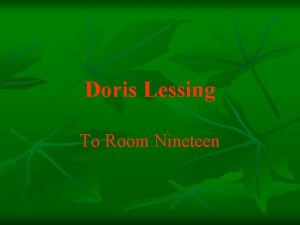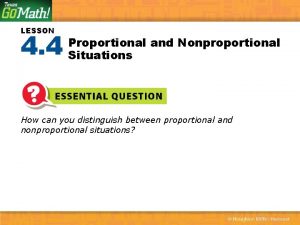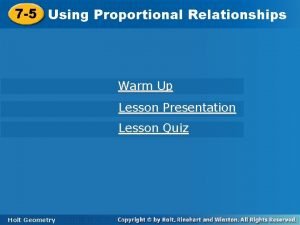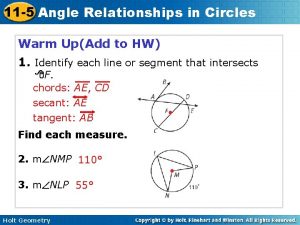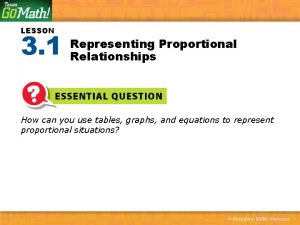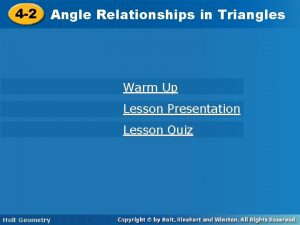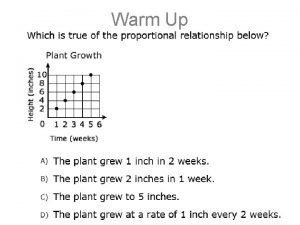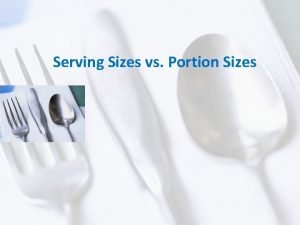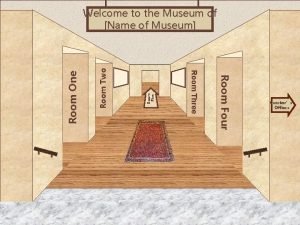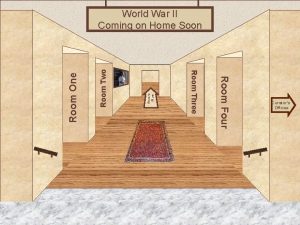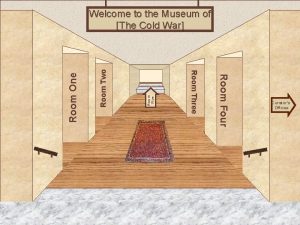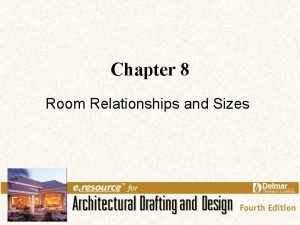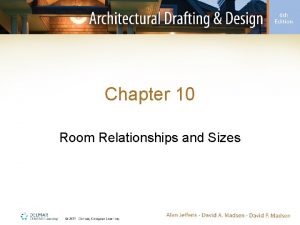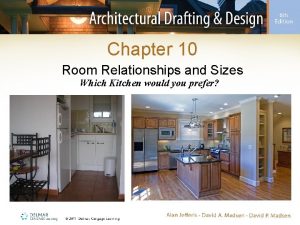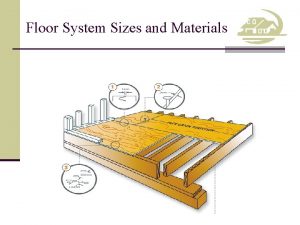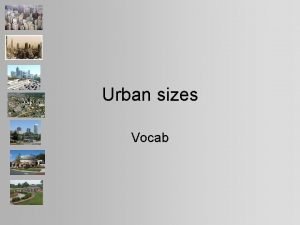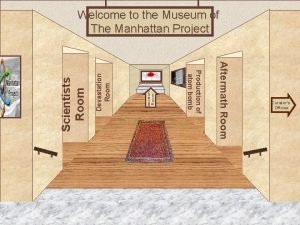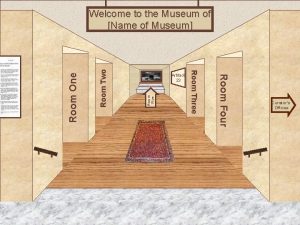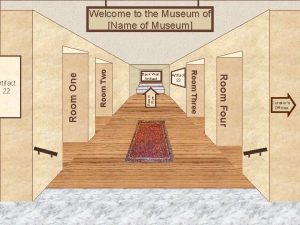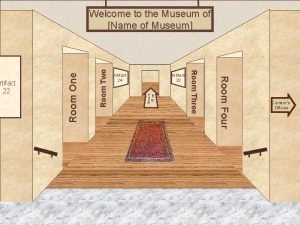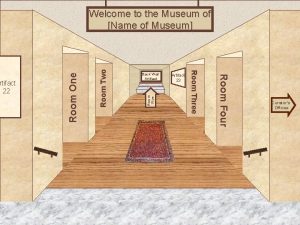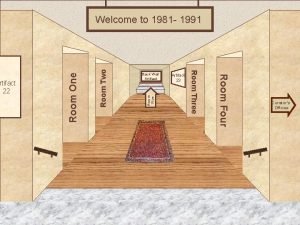Room Sizes and Relationships Gateway Lesson 1 9
























- Slides: 24

Room Sizes and Relationships Gateway – Lesson 1. 9 – Green Architecture © 2012 Project Lead The Way, Inc.

Room Relationships Three Areas • Living Area • Sleeping Area • Service Area

LIVING AREAS

Living Area Formal Living Area • General size 13’ x 18’ o Guest entertaining o Quiet conversation o Near entry

Living Area Informal Living Area • Guest entertaining • Family entertaining • Everything room • General size 13’ x 16’

Living Area Dining Room • Easy access to living and kitchen • Nook for smaller spaces • Casual dining room 9’ X 11’ • Formal dining room 11’ x 14’

Living Area Characteristics • Residents and guests play and relax here • Natural light and scenic views are desirable (except in a home theater) • A formal entrance or foyer is placed in or near the main living space • What rooms are part of the living area?

Sleeping Area

Sleeping Area Bedrooms • Sizes vary • Master bedroom 13’ x 16’ + • Master bathroom 6’ x 9’ • Entrance through master bedroom. • General/Medium size bedroom 9’ x 10’ to 12’ x 14’

Sleeping Area Closets Minimum 4’ wide x 24” deep Every bedroom Noise buffers • Master bedrooms have walk-in closets • Walk-in minimum 6’ x 6’ • Linen closet • 2’ wide x 18” deep

Sleeping Area Characteristics • Bedrooms should be private; should not walk through a bedroom to get to another room. • Bedrooms are kept away from busy areas of a house. Privacy, noise levels, activity, and room adjacencies are considered when planning bedroom locations. • Master bedrooms may include a sitting area, master bathroom, or walk-in closet. • What rooms are part of the sleeping area?

SERVICE AREAS

Service Area Bathrooms • Privacy from living areas • Easy access from other areas • 2 or more placed back-to-back • ½ bath = Lavatory and WC • ¾ bath = Lavatory, WC, shower • Full bath = Lavatory, WC, tub • Master bath = Lavatory, WC, tub, separate shower • General size 6’ x 9’

Service Area Laundry Room • May contain sink, folding table, clothes rack, ironing board • Laundry supplies storage • May be near exterior access for hanging clothes outside • Keep near other rooms that need plumbing • General size: small – 33” x 66”, large – 10’ x 10’

Service Area Garage • Vehicle storage • Yard equipment storage • Sport equipment storage • Firewall between attached garage and house • General size: one-car 12’ x 24’, two-car 22’ x 24’

Service Area Kitchen • Used the most • View of play areas, inside and out • Close to exit (carrying in groceries) • Kitchen layout ~ working triangle • Major appliances need to be within 4 -9 feet of each other • Stove, sink, refrigerator, dishwasher General Size 10’ x 10’

Service Area Characteristics • Service or working areas are often grouped together to reduce plumbing cost. • These areas are often noisy. • When designing a two-story home, a bathroom should be on each level. • What rooms are part of the service area?

Working Triangle • The working triangle is the distance between the most common three work spaces in a kitchen: Stove, refrigerator, and sink. • The work triangle has points at front center of sink, front center of stove, and front center of refrigerator. • The perimeter should be between 12’ and 21’.

Working Triangle A. B. C. The traffic flow through the kitchen can often disrupt work. A. This kitchen has no through traffic. B. This kitchen has cross traffic through the work area of the sink, refrigerator, and stove. C. This kitchen has disruptive traffic through the work area. How can we fix them?

Common Rooms

In What Area Does Each Room Belong? • • Living Room Basement (not finished) Bathroom (part finish) Basement Bedroom Garage Kitchen Patio Dining Room Office Family Room Library Laundry Room Service Living Sleeping Service Living Service

Answers 6 1. ______ 2. ______ 3. ______ 2 1 3 4. ______ 5. ______ 6. ______ 4 7 5 8 10 7. ______ 8. ______ 9. ______ 10. ______ 9 Identify the type of area for each room.

Answers 6 1. Living area 2. Living area 3. Service area 2 1 3 4. Service area 5. Sleeping area 6. Living area 4 7 5 8 7. Service area 8. Sleeping area 9. Sleeping area 10. Service area 9 SMALL HOUSE PLAN 10

Resources Microsoft, Inc. (2011). Clip art. Retrieved from http: //office. microsoft. com/en-us/clipart/default. aspx
 Men's shirt sizes are determined by their neck sizes
Men's shirt sizes are determined by their neck sizes Ba-room ba-room ba-room baripity
Ba-room ba-room ba-room baripity Downstairs
Downstairs To room 19
To room 19 Hotel database sql queries
Hotel database sql queries 5.3 linear relationships and bivariate data
5.3 linear relationships and bivariate data Lesson 7-1 parallel lines and angle relationships
Lesson 7-1 parallel lines and angle relationships Lesson 4 proportional and nonproportional relationships
Lesson 4 proportional and nonproportional relationships Lesson 4-4 proportional and nonproportional situations
Lesson 4-4 proportional and nonproportional situations Small effect size
Small effect size Are sold in the market fresh and sometimes alive
Are sold in the market fresh and sometimes alive Estimating parameters and determining sample sizes
Estimating parameters and determining sample sizes Ventroglute
Ventroglute Healthy vs unhealthy sibling relationships
Healthy vs unhealthy sibling relationships Glencoe health chapter 7
Glencoe health chapter 7 Chapter 7 family relationships
Chapter 7 family relationships Lesson 7-5 using proportional relationships answers
Lesson 7-5 using proportional relationships answers Unit 10 circles homework 7 segments lengths
Unit 10 circles homework 7 segments lengths Lesson 11-5 problem solving angle relationships in circles
Lesson 11-5 problem solving angle relationships in circles Representing proportional relationships
Representing proportional relationships Lesson 2-8 proving angle relationships
Lesson 2-8 proving angle relationships Lesson 1-5 angle relationships answers
Lesson 1-5 angle relationships answers Lesson 4-2 angle relationships in triangles
Lesson 4-2 angle relationships in triangles 3.1 graphing relationships
3.1 graphing relationships Lesson 10 interpreting graphs of proportional relationships
Lesson 10 interpreting graphs of proportional relationships



